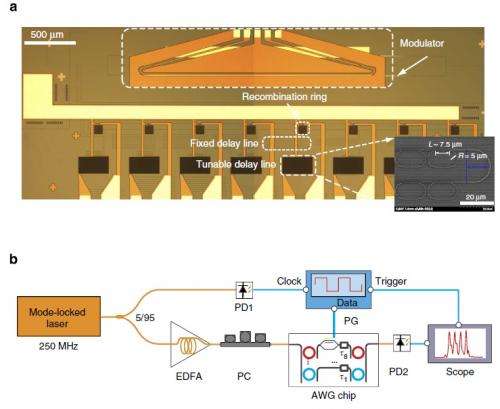February 19, 2015 feature
Rapidly reconfigurable waveform generator on a CMOS chip could be used for high-speed wireless communication

(Phys.org)—An arbitrary waveform generator can, as its name implies, generate waves of almost any shape by controlling the amplitude, frequency, phase, and other wave characteristics. Waveform generators working in the radio frequency (RF) regime have a wide variety of uses in electronics, including wireless communication, radar, high-speed testing, and anywhere complex signals are needed. Typically, waveform generators are about the size of a DVD player. However, future wireless applications will require waveform generation and processing on a silicon chip.
Working toward this goal, engineers and scientists at Purdue University in West Lafayette, Indiana, and the Chinese Academy of Sciences in Shanghai have designed and fabricated a device that can generate RF waveforms on a silicon chip with reconfiguration speeds of just 4 nanoseconds. Their work is published in a recent issue of Nature Communications.
The new waveform generator uses light instead of electricity to create RF waves, and offers high pulse bandwidth, low phase noise, and the capability of intra-pulse modulation—all traits that are difficult to achieve by electronic means.
"Photonics-assisted RF waveform generation includes two major steps: creating arbitrary optical waveforms through optical pulse shaping, and converting the optical signals to the RF domain," said Dr. Jian Wang at Purdue University, the lead author of the paper. "Whereas integrated high-speed photo-detectors have been well developed for the latter step, the bottleneck is the first step: a fully integrated optical pulse shaper that is capable of high-speed reconfiguration."
In the researchers' previous work, their device required a 5-km-long spool of optical fiber to perform the required optical delay. Wang explained that the new version eliminates the requirement for the long fiber, and instead uses integrated silicon waveguides and resonators to precisely control optical delays on the picosecond (10-12 second) scale.
Not only is the device extremely small, it is also extremely fast. Its nanosecond reconfiguration speed is three orders of magnitude faster than traditional photonics-assisted RF generation solutions. Fast reconfiguration speeds are especially important for applications such as communications and information processing, where high data throughput is essential. Different from earlier photonic approaches that were built based on liquid crystal modulation or the thermo-optic effect, the device takes advantage of silicon's fast electro-optic effect to improve the device response time.
"The reported reconfiguration speed of 4 nanoseconds was limited by the light source rather than the capability of our device," said coauthor Minghao Qi, an associate professor at Purdue University. He expects reconfiguration speeds of more than 10 GHz using on-chip frequency comb sources, which are currently under development in the group of Qi and Andrew Weiner, a professor at Purdue.
From a practical perspective, the engineers demonstrated that the miniature device can be fabricated with high-yield and low-cost manufacturing techniques at a commercial CMOS foundry. It also has the potential to be seamlessly integrated with other on-chip components, such as high-speed germanium photo-detectors, optical frequency combs sources, and control electronics.
With these advantages, the waveform generator on a chip could play a vital role in future high-speed wireless technology, defense electronics, high-speed signal processing, and other emerging applications.
More information: Jian Wang, et al. "Reconfigurable radio-frequency arbitrary waveforms synthesized in a silicon photonic chip." Nature Communications. DOI: 10.1038/ncomms6957
Journal information: Nature Communications
© 2015 Tech Xplore




















